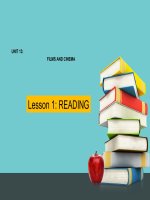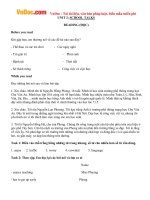Giải bài tập SGK tiếng Anh lớp 10 Unit 13 FILMS AND CINEMA
Bạn đang xem bản rút gọn của tài liệu. Xem và tải ngay bản đầy đủ của tài liệu tại đây (820.12 KB, 12 trang )
VnDoc - Tải tài liệu, văn bản pháp luật, biểu mẫu miễn phí
Giải bài tập SGK tiếng Anh lớp 10 Unit 13 FILMS AND CINEMA
A. Reading (Trang 132-133-134 SGK Tiếng Anh 10)
Before you read (Trước khi bạn đọc)
Work with a partner. Answer the questions. (Làm việc với bạn học. Trả lời các câu hỏi sau.)
Rạp chiếu phim quốc gia
1. Do you want to see a film at the cinema or TV? Why? (Bạn muốn xem phim ở rạp chiếu phim hay ở
trên tivi? Tại sao?)
=> I want to see a film on TV at home, because I feel more comfortable and free from the noise.
2. Can you name some of the films you have seen? (Bạn có thể kể một vài phim bạn đã được xem
không?)
=> I've seen some films such as "Ma tran", "Tay Du Ky", "Toi thay hoa vang tren co xanh" and "Co dau
8 tuoi", ...
3. What kind of films do you like to see? Why? (Bạn thích xem thể loại phim gì? Tại sao?)
=> I like to see story and science films because these films reflect the facts in real life and convey moral
ideas in the film stories, and in science films I can learn more about things around us.
While you read (Trong khi bạn đọc)
Read the passage, and then do the tasks that follow. (Đọc đoạn văn, và sau đó làm các bài tập theo sau.)
VnDoc - Tải tài liệu, văn bản pháp luật, biểu mẫu miễn phí
Hướng dẫn dịch:
Lịch sử của cái mà chúng ta ngày nay gọi là điện ảnh bất đầu từ đầu Thế kỷ 19. Vào lúc đó
các nhà khoa học đã phát hiện ra rằng khi làm cho một loạt các bức ảnh chuyển động,
chúng sẽ cho người ta cái cảm giác là chúng đang chuyển động thật. Điện ảnh phát triển
nhanh chóng trong hai thập niên đầu kể từ khi ra đời. Trong thời gian đầu, phim không gì
hơn là những bức ảnh biết chuyển động và thường có độ dài chỉ hơn một phút. Tuy nhiên
cho đến năm 1905 phim dài từ năm đến mười phút. Phim sử dụng các cảnh quay và các vị
trí đặt máy quay khác nhau để tạo nên một cốt truyện có các diễn viên tham gia đóng các
vai khác nhau. Vào đầu thập niên 1910, khán giả đã có thể thường thức những bộ phim hài
đầu tiên, nhưng mãi đến năm 1915 điện ảnh mới thực sự trở thành một ngành công nghiệp.
Từ đó trở đi các nhà làm phim sẵn sàng làm những bộ phim dài hơn, hay hơn và xây dựng
rạp riêng để chiếu phim. Điện ảnh hoàn toàn thay đổi vào cuối những năm 1920. Đó là khi
âm thanh được lồng vào phim. Sự thay đổi này bắt đầu ở Mỹ và chẳng bao lâu sau lan ra
khẳp thế giới. Khi phim câm được thay thế bởi phim có tiếng nói, một loại hình điện ảnh
mới xuất hiện, đó là điện ảnh âm nhạc.
Task 1. Find the word in the passage that can match with the definition on the right column. (Tìm từ
trong đoạn văn mà có thể ghép với định nghĩa ở cột phải.)
1. cinema: rạp chiếu phim
2. sequence: cảnh (trong phim), sự liên tiếp
3. decade: thập kỉ
4. rapidly: nhanh chóng
5. scene: màn (của phim)
6. character: nhân vật
Task 2. Work in pairs. Answer these questions. (Làm việc theo cặp. Trả lời câu hỏi.)
1. When did the history of cinema begin? (Lịch sử của điện ảnh bắt đầu khi nào?)
VnDoc - Tải tài liệu, văn bản pháp luật, biểu mẫu miễn phí
=> The history of cinema began in the early 19th century.
2. What did scientists discover at the time? (Các nhà khoa học đã phát minh ra cái gì trong thời gian
đó?)
=> At that time, scientists discovered that when a sequence of still pictures were set in motion, they could
give the feeling of movement.
3. Did films in the early days have sound? (Các phim trong thời gian đầu có âm thanh không?)
=> No, they didn't.
4. When were audiences able to see long films? (Khi nào thì các khán giả có thể xem các bộ phim dài?)
=> Audiences were able to see long films in the easrly 1920s.
5. When was sound introduced? (Âm thanh được giới thiệu vào khi nào?)
=> The sound was introduced at the end of the 1920s.
6. What form of films appeared as the old silent films were being replaced by spoken ones? (Loại hình
điện ảnh nào đã xuất hiện khi các phim câm được thay thế bằng phim có tiếng nói?)
=> As the old silent films were being replaced by spoken ones, the musical cinema appeared.
Task 3. Decide which of the options below is the best title for the passage. (Xác định lựa chọn nào trong
những lựa chọn dưới đây là tiêu đề đúng nhất cho đoạn văn.)
B. A Brief History of Cinema (Lịch sử tóm tắt của điện ảnh)
After you read (Sau khi bạn đọc)
Work in groups. Talk about the passage, using the cues below. (Làm việc nhóm. Nói về đoạn văn, dùng từ
gợi ý dưới đây.)
19 th century
1905
1910s
1915
1920s
VnDoc - Tải tài liệu, văn bản pháp luật, biểu mẫu miễn phí
Gợi ý:
Cinema began in the early 19th century. And by 1905, films were about five or ten minutes
long. In the early 1910s, audiences were able to enjoy the first long films. And it was not
until 1915 that cinemas really became an industry. At the end of the 1920s, the cinema
changed completely.
B. Speaking (Trang 134-135 SGK Tiếng Anh 10)
Task 1. How much do you like each kind of film? Put a tick (✓) in the right column. Then compare your
answer with a partner's. (Bạn thích mỗi thể loại phim như thế nào? Tích dấu (✓) vào cột phải. Sau đó so
sánh câu trả lời với của bạn em.)
Task 2. Work in groups. Find out what your friends feel about each kind of film. Use the words in the
table below. (Làm việc nhóm. Tìm xem cảm nhận của các bạn của em về mỗi thể loại phim. Sử dụng các
từ trong bảng dưới đây.)
Gợi ý:
A: What do you think of horror films?
B: Oh, I find them really terrifying.
C: I don't quite agree with you. I find them interesting.
VnDoc - Tải tài liệu, văn bản pháp luật, biểu mẫu miễn phí
A: What do you think of action films?
D: Oh, I find them really good fun.
E: I agree with you and I find them even exciting.
Tương tự với các thể loại phim khác.
Task 3. Work with a partner. Find out his/her preferences for films. Use the cues below. (Làm việc với
một bạn học. Tìm xem bạn ấy thích thể loại phim nào hơn. Dùng từ gợi ý bên dưới.)
Gợi ý
A: Which do you prefer, horor films or detective films?
B: Well, it's difficult to say. But I suppose I prefer detective films to horor ones.
A: What about love Story films and cartoons?
B: For me, cartoons are more interesting because they give us relaxing minutes after hard work.
Task 4. Work in groups. Talk about a film you have seen. Use the suggestions below. (Làm việc nhóm.
Nói về phim em đã xem. Dùng những gợi ý bên dưới.)
1. Em xem phim đó ở đâu?
2. Đó là loại phim gì?
3. Bộ phim đó nói về điều gì?
4. Ai là nhân vật chính trong phim?
5. Em cảm nhận thế nào về bộ phim ấy?
6. Tại sao em thích bộ phim ấy hơn những bộ phim khác?
Bài viết gợi ý:
Last week we went to see a film called "The Journex” at the city cinema. It was a detective
comic film. It wets really good. I was really excited while I was watching it.
VnDoc - Tải tài liệu, văn bản pháp luật, biểu mẫu miễn phí
Two young Americans found an old car, which was really valuable. An organization was
looking for the car, which they didn't want to be known by the police. The young men
hadn't known about it at all. When they were driving through cities, suddenly they were
shot by somebody. This story began from this scene. They drove with nice technic and
speedy. Because they were driving from countryside to big cities, we could see a lot of
various beautiful views; for example we could see vast fields, and in cities they showed us
their skilful driving between skyscrapers, and played a hoax on the chasers. At last, after a
long journey, these young wen took the car to the local authories.
It is a comic film, therefore it can relux our mind by Hiving us a lot of laughters.
C. Listening (Trang 136-137 SGK Tiếng Anh 10)
Before you listen (Trước khi bạn nghe)
- How often do you do each of the following? Put a tick (✓) in the right column. Then compare your
answers with a partner's. (Bao lâu em làm mỗi việc sau đây một lần? Tích dấu (✓) vào cột bên phải. Sau
đó so sánh các câu trả lời của em với của bạn cùng học.)
Tùy vào từng người thì chúng ta sẽ có bảng kết quả khác nhau, ví dụ:
- Listen and repeat.
VnDoc - Tải tài liệu, văn bản pháp luật, biểu mẫu miễn phí
Titanic: bộ phim Titanic
cinema: rạp chiếu phim, phim ảnh
instead: để thay cho, thay vì
suppose: giả sử
guess: dự đoán
picnic: chuyến dã ngoại
While you listen (Trong khi bạn nghe)
Task 1. Listen to the dialogue. What are Lan and Huong planning to do together? (Nghe bài hội thoại.
Lan và Hương đang dự định làm gì?)
They are going to go to the cinema together to see "The Titanic".
TAPESCRIPT - Nội dung bài nghe:
Lan: Hi, Huong. The Titanic is on at Thanh Tam Cinema next week. Can you go with me
on Wednesday?
Huong: Wednesday? Sorry, Lan. I have lots of work to do during the day and I'm going to
the singing club at night. Can we go on Thursday, instead?
Lan: I don't think so. I'm going to see a play with Tuyet on Monday. What about Friday?
Huong: Sorry Lan. Friday is not a good time for me. I'm taking Chinese classes on Fridays.
How does your weekend look like, Lan?
Lan: Um... I'm busy on Saturday. But I'm free the whole day Sunday.
VnDoc - Tải tài liệu, văn bản pháp luật, biểu mẫu miễn phí
Huong: I'm going on a picnic to Hoa Lu with some of my friends on Sunday. I'll be back
late at night.
Lan: Well, I guess that we just leave ... Uh, wait a second, what day are we both free,
Huong?
Task 2. Listen again. Write their plans for the next week on the calendar. (Nghe lại. Viết kế hoạch của họ
cho tuần tới trên lịch.)
Lan
Mon
Huong
See a play
Tues
Wed
Thurs
Work and go to the singing club
Visit grandparents
Fri
Sat
Study Chinese
Work (busy)
Sun
Go on a picnic
Task 3. Compare your answers with a partner's. On what day can they meet? (So sánh câu trả lời của em
với câu trả lời của một bạn cùng học. Họ có thể gặp nhau vào ngày nào?)
Từ lịch trên, ta suy ra:
They can meet on Tuesday.
After you listen (Sau khi bạn nghe)
Work in groups. Talk about Lan and Huong's plan for the next week. Use the information you have
written on the calendar. (Làm việc nhóm. Nói về kế hoạch của Lan và Hương cho tuần tới. Dùng thông
tin em đã viết trên lịch.)
VnDoc - Tải tài liệu, văn bản pháp luật, biểu mẫu miễn phí
Gợi ý:
According to the calendar, we find out what Lan and Huong are planning to do for the next
week.
On Monday, Lan is going to see a play with her friend, Tuyet. And on Thursday, she is
visiting her grandparents, and on Saturday, she'll be busy working.
Meanwhile on Wednesday, Huong has lots of work to do and she is going to the singing
club at night. And on Friday, she is studying Chinese and on Sunday, she's going on a
picnic with some of her friends.
D. Writing (Trang 137-138 SGK Tiếng Anh 10)
Describing a film (Mô tả một bộ phim)
Task 1. Read the following description of the film Titanic, and then answer the questions below. (Đọc
bài mô tả sau về phim Titanic, và sau đó trả lời các câu hỏi bên dưới.)
Hướng dẫn dịch:
Trong tất cả bộ phim tôi đã xem. Titanic là bộ phim tôi thích nhất. Titanic là bộ phim tình
yêu bi thảm. Nó nói về một con tàu sang trọng bị chìm ngay trong chuyến đi biển đầu tiên
vượt Đại Tây Dương. Bộ phim được thực hiện ở Mỹ, nó dựa vào câu chuyện có thật về
thảm họa tàu Titanic năm 1912. Nhân vật chính của phim là Jack Dawson và Rose Dewitt
Bukater. Jack Dawson là một thanh niên hào phóng, thích phiêu lưu mạo hiểm trên tàu.
Jack đã ngăn không cho Rose tự tử, và mặc dù cô đã đính hôn nhưng hai người vẫn yêu
VnDoc - Tải tài liệu, văn bản pháp luật, biểu mẫu miễn phí
nhau. Con tàu đâm phải tảng băng trôi và chìm nhanh. Hơn một nghìn người thiệt mạng
trong thảm họa này, trong đó có Jack Dawson.
1. What is the name of the film? (Tên bộ phim là gì?)
=> It is Titanic.
2. What kind of film is Titanic? (Titanic thuộc thể loại phim nào?)
=> Titanic is a tragic love story film.
3. What is it about? (Phim kể về cái gì?)
=> It is about the sink of a luxury liner on her first voyage across the Atlantic Ocean.
4. Where is it made? (Nó được thực hiện ở đâu?)
=> It is made in America.
5. What is it based? (Phim dựa trên cái gì?)
=> It is based on the true story of the Titanic disaster in 1912.
6. Who is/are the main character(s)? (Ai là nhân vật chính?)
=> The main characters in Titanic are Jack Dawson and Rose DeWiti Bukater.
7. What do you know about the character(s)? (Bạn biết gì về các nhân vật chính?)
=> Jack is a young and generous adventurer and Rose is a beauiiful girl who is already engaged.
8. Does the film have a happy or a sad ending? (Bộ phim có một kế thúc có hậu hay kết thúc buồn?)
=> The film has a sad ending.
Task 2. Write about a film you have seen. Use the description of Titanic and the questions above as
suggestions. (Viết về một phim em đã xem. Dùng mô tả của phim Titanic và các câu hỏi trên như là gợi
ý.)
Gợi ý:
VnDoc - Tải tài liệu, văn bản pháp luật, biểu mẫu miễn phí
Poseidon is the film I have seen recently. It is a moving film. Just like Titanic, Poseidon is
the name of luxury liner which is hit by huge waves and sinks down on the New Year Eve.
The main characters are Dylan Johns who tries to resuce himself instead of waiting for the
death; Robert Ramsey and Richard Dreyfuss, a waiter who knows the building structure of
the liner. All of them attempt to find the way for their lives - with understanding, sympathy
and solidarity they all succeed. The film has a happy ending.
E. Language Focus (Trang 139-140-141 SGK Tiếng Anh 10)
Grammar and vocabulary (Ngữ pháp và từ vựng)
Exercise 1. Write the adjective forms of the verbs below. (Viết dạng tính từ của các động từ dưới đây.)
1. fascinate --> fascinating
6. bore --> boring
2. excite --> excting
7. suprise --> suprising
3. terrify --> terrifying
8. amuse --> amusing
4. irritate --> irritating
9. embarrass --> embarrassing
5. horrify --> horrfying
10. frustrate --> frustrating
fascinate: quyến rũ
irritate : làm phát cáu
terrify
horrify
embarrass: làm lúng túng
: làm kinh hãi
: làm khiếp sợ
frustrate: làm thất vọng
Exercise 2. Complete two sentences for each situation. Use an adjective ending -ing or -edform of the
verb in brackets to complete each sentence. (Hoàn thành hai câu cho mỗi tình huống. Dùng tính từ tận
cùng với -ing hoặc -ed của động từ trong ngoặc để hoàn thành mỗi câu.)
1.
2.
3.
4.
5.
a) depressing
a) interested
a) boring
a) excited
a) exhausting
VnDoc - Tải tài liệu, văn bản pháp luật, biểu mẫu miễn phí
b) depressed
b) interesting
b) bored
b) exciting
b) exhausted
Exercise 3. Rewrite the following sentences. (Viết lại các câu sau.)
1. It was not until 1990 that she became a teacher.
2. It was not until he was so that he knew how to swim.
3. It was not until 1980 that they began to learn English.
4. It was not until his father came home that the boy did his homework.
5. It was not until the lights were on that football match started.
Exercise 4. Put a(n) or the in the numbered blanks. (Điền a(n) hoặc the vào các chỗ trống đã được đánh
số.)
1.
2.
3.
4.
(1) a
(4) an
(10) the
(14) an
(2) The
(5) a
(11) the
(15) a
(3) the
(6) a
(12) the
(16) a
(7) the
(13) the
(17) the
(8) the
(9) the
(18) a









